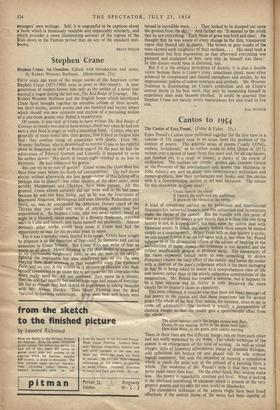Irish Travellers
The Stranger in Ireland. By Constantia Maxwell. (Cape. 25s.) 'THE Irish are fond of strangers,' M. de La Boullaye-le-Gouz decided in 1653; and later travellers have usually echoed him. Arthur Young noted that his hosts on his tour of Ireland spent their incomes on hospitality instead of on their estates—or their animals: he heard of a guest on his way to bed in a country house who encountered a ravenous greyhound 'which, jumping up, took the candle out of the candlestick and devoured it in a trice, leaving him in the dark.' Walter Scott confessed that not even Scottish hospitality could match that of Ireland—'everything seems to give way to the desire to accommodate a stranger.' One only of Constantia Maxwell's strangers' gallery—and they are an entertainingly cosmopolitan crew —put in a demurrer: Francisco de Cuellar, an Armada sea captain who was cast away on the Irish coast. Those of his countrymen who were not executed by the authorities as the Queen's enemies were hunted and slaughtered by the natives for plunder. Cuellar himself was lucky to survive: but no sooner would he find some 'savages' to befriend him and provide him with clothing, than others arrived to beat him and leave him stripped again.
Cuellar found that the Irish 'do not eat oftener than once a day, and this is at.flight; and that which they usually eat is butter with oate Lid. They drink sour milk, for they have no other drink; jhe o not drink water, although it is the best in the world.' Soon, oaten bread was to give way to the potato, and by the time le Chevalier de la Tecnaye toured Ireland in the 1790s, poverty and squalor had joined hospitality as the characteristics which most impressed themselves on the visitor. By travelling light—he carried his luggage with him wrapped up in a handkerchief—he saw more of the people than most tourists. 'A pair of breeches fine enough to be rolled into a lump as big as a man's fist' enabled him to appear fashionable whcn he was entertained by the aristocracy; but he could also look enough of a wanderer to be welcomed in the peasants' huts, filthy structures of kneaded mud and straw, without chimneys or windows, housing the livestock as well as the inevitable swarm of children.
I can think of no better introduction to Irish history than these travellers' tales : but The Stranger in Ireland has some defects. The author's (or perhaps the publisher's) decision to have the strangers prefaced by a potted history of Ireland was sensible, but it has led to a tiresome amount of repetition. The quality of the visiting team varies: some should have been dropped in favour of more suitable candidates. Bianconi was a stranger in Ireland only in the sense that Einstein is a stranger in America: in any case his impressions coma at second-hand, through the biography of him by his daughter. And Thackeray's Sketch Book is still fresh enough to bloom in its own right: it needs no re-introduction.
The most serious fault is the amount of irrelevant material included. Edmund Spenser wrote perceptively on Ireland: a pity, then, to squeeze out his views in order to make room for miscellaneous biographical information unconnected with his Irish career, such as a discussion whether he died at Westminster from lack of bread. And nothing is added to the Cuellar tale by the information that the men of the Armada went to confession on an island in Corunna harbour. Drastic pruning of the author's intrusive running com- mentary would have helped, leaving room for more extracts from the strangers' own writings. Still, it is ungrateful to be captious about st book which is immensely readable and impeccably scholarly, and which provides a more illuminating account of the regress of the Irish down to the Famine period than do any of the standard text- books.
BRIAN INGLis



































 Previous page
Previous page